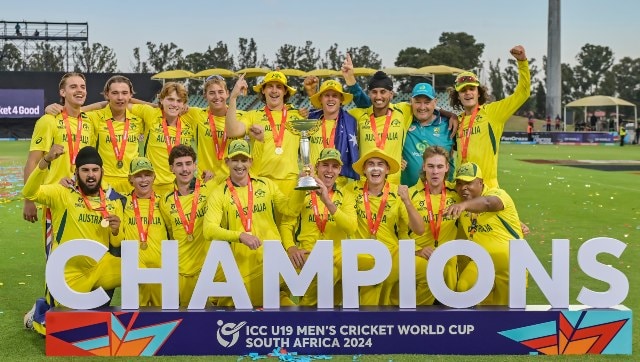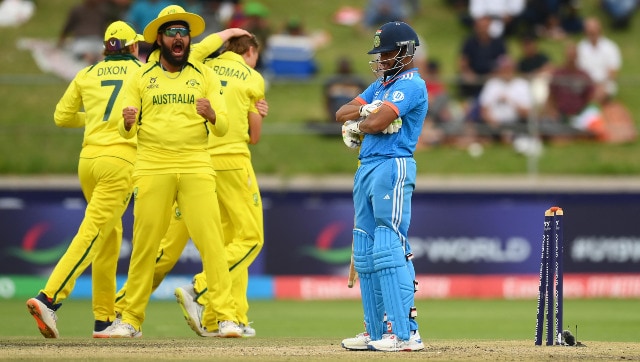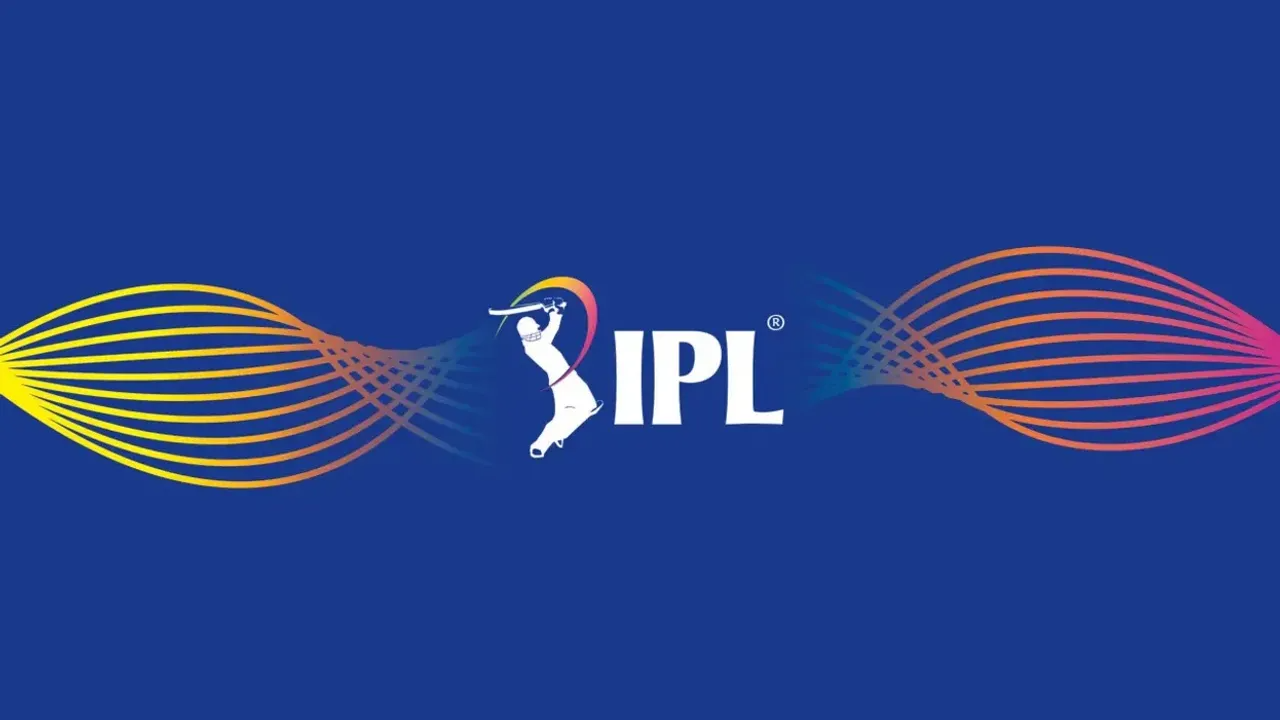Team India just can’t catch a break in ICC events, especially when it comes to facing Australia in knockout matches.
The Harmanpreet Kaur-led side had been knocked out by eventual winners Australia in the semi-finals of the Women’s T20 World Cup last year. Pat Cummins’ men would then get the better of Rohit Sharma and Co twice in a space of five months — in the final of the World Test Championship and later in the ICC World Cup.
That curse appears to have made its way to youth cricket now, with the Uday Saharan-led Indian team finishing on the wrong side of the result in the final of the 2024 U-19 World Cup in Benoni on Sunday. Their journey in the tournament was no different from that of the Men in Blue in the home World Cup last year, both teams suffering a comprehensive defeat to Australia in the final after bossing their way to the knockouts.
As It Happened: India vs Australia, 2024 U-19 World Cup Final
India did have a narrow escape against a spirited South African team that had reduced them to 32/4 after setting them a challenging 245 to win, thanks primarily to the middle-order pair of Sachin Dhas and skipper Saharan and their 171-run fifth-wicket partnership. The semi-final scare might have been seen by a section of Indian supporters as a timely wake-up call of sorts for the ‘Boys in Blue’ ahead of the biggest game of them all.
India, after all, were up against a team that knows how to rise to the occasion in the big games regardless of the format or age/gender. And it wasn’t just the Indians who had entered the final unbeaten; Australia too had not lost a single match and appeared to be peaking at the right time.
 Australia managed to close the gap with India in terms of U-19 world titles, winning their fourth on Sunday with a comprehensive victory over the ‘Boys in Blue’. AP
Australia managed to close the gap with India in terms of U-19 world titles, winning their fourth on Sunday with a comprehensive victory over the ‘Boys in Blue’. APIn the end, Australia did what Australia does best — win the matches that matter to lift the title at the end of the tournament. As for the Indian team, they aren’t quite used to bottling the big games at the U-19 level as they are in the senior men’s and women’s divisions, having reached each of the last five youth World Cup finals and emerged winners on two of those occasions, including against the Aussies in 2018.
Try telling that to the Indian cricket fans though. The reactions and trending hashtags on social media platforms such as X after the latest defeat tells you that quite a few of them are yet to recover from the heartbreak that they suffered on 19 November, with Sunday’s loss further rubbing salt on the wounds for those fans.
Indian batters crumble under pressure
It wasn’t all doom and gloom for the Indian team from the word go as had been the case in the 2003 World Cup final, incidentally in the same country and against the same team albeit at the senior level.
Raj Limbani did manage to get Sam Konstas out for an eight-ball duck in his second over of the innings and Naman Tiwari bounced back from an expensive first over to remove skipper Hugh Weibgen and well as Harry Dixon in consecutive overs after a solid second-wicket partnership between the two worth 78. Spinners Saumy Pandey and Musheer Khan too pitched in with a wicket each, the former finishing at the second spot on the leading wicket-takers’ list behind South Africa’s Kwena Maphaka in the process.
A sparkling 55 from Harjas Singh, who rose to the occasion in the final after struggling throughout the tournament, as well as an unbeaten 46 off just 43 deliveries from Oliver Peake helped the Aussies post a competitive 253/7 on the board after skipper Weibgen opted to bat. Had it not been for those two, the Aussies might well have struggled to cross 200.
The previous highest target successfully chased in U-19 World Cup history was 242, achieved by England against New Zealand in 1998, and India needed to surpass that record if they were to successfully retain their title and win the tournament for a record-extending sixth consecutive time. After their exploits against the Proteas in a thrilling semi-final at the same venue, Saharan and his teammates would have backed themselves to pull off the job at the Willowmoore Park.
It was in the chase, however, that the Indians ended up getting outplayed by a clinical pace-heavy Australian attack that, combined with Weibgen’s smart bowling changes and field placements, ensured they never really were in the contest save for a couple of phases.
It started with a superb opening spell from Callum Vidler, who began with a maiden and got opener Arshin Kulkarni caught-behind with a beautiful away-swinger in his next over. The early wicket would force the ‘Boys in Blue’ to go into a shell as the pair of Adarsh and Musheer Khan crawled through the remainder of the powerplay, taking India to 28/1 .
Musheer, who had been dropped by Dixon at slip on nought, would begin to shift gears after the conclusion of the powerplay, producing a beautiful straight drive off Vidler in the final over of the seamer’s opening spell before welcoming Mahli Beardman into the attack with a flick in front of square for a boundary.
India certainly were on the rise at this stage with the scorecard reading 40/1 at the start of the 13th over. Musheer had assumed charge in the second-wicket stand and had just entered the 20s with a boundary off Beardman, while Adarsh was providing steady support from the other end.
Beardman, however, would strike in his second delivery of the day, right after getting hit for a boundary, as the in-form Musheer chopping the ball onto the stumps off the bottom-edge while attempting to defend a delivery that stayed a touch low.
 India batter Musheer Khan reacts after getting cleaned up by Australia seamer Mahli Beardman. Image credit: ICC
India batter Musheer Khan reacts after getting cleaned up by Australia seamer Mahli Beardman. Image credit: ICCThat was the beginning of the procession to the Indian dressing room as Adarsh would stand tall at his end while wickets tumbled at regular intervals at the other, often in clusters. And more often than not, it was some questionable shot-selection that was to blame for the Indian batters losing the plot in the middle overs.
Captain Saharan had not been dismissed for a single-digit score throughout the tournament, and had done a fabulous job of absorbing the pressure and rotating strike with Dhas in the semi-final. He would become the second of Beardman’s three victims in the final, slashing hard at a short-of-length delivery outside off to send the ball straight into the hands of his opposite number at backward point, departing for 9.
Dhas would follow shortly after, poking at a delivery that got some late away-drift to result in an outside edge straight into the hands of the keeper, giving offie Raf MacMillan — the only spinner in the Australian attack — a wicket off his first ball of the day.
It wasn’t over for the Indians though as they still had opener Adarsh at the centre in the company of Priyanshu Moliya, with hard-hitting keeper-batter Aravelly Avanish and Murugan Abhishek to follow. As was the case in the semis, where they were four-down with half as many runs chasing a similar target, they needed one solid partnership to revive their title hopes.
And Adarsh was doing just that in the company of Moliya as the pair cautiously added 22 runs for the fifth wicket before the latter, perhaps in a rush of blood, ended up chipping the ball straight to Vidler at mid-on while attempting to pull Charlie Anderson out of the park. Sure India were collecting runs at a steady rate, and hadn’t breached the 100-mark close to the halfway stage of the chase. That, however, does little to justify such a tame dismissal at a crucial juncture of the innings.
Avanish would then head back to the pavilion almost as soon as he made his way to the centre and took guard, chipping the ball back to MacMillan to give the off-spinner his second wicket and depart for a two-ball duck.
Adarsh would then attempt to put the Aussies under pressure by finally showing some intent, collecting a four and a six off successive deliveries from Vidler. The southpaw, however, would perish shortly after while attempting a similar shot off Beardman’s bowling, getting caught-behind on 47 and giving the seamer his third wicket of the day
At 115/7 with their last set batter gone, the match was as good as over and the remainder of the game appeared a mere formality for the Aussies to complete. Abhishek managed to frustrate the Aussies with a counter-attacking 42 off 46 deliveries that contained five fours and a six, stitching a 46-run ninth-wicket stand with Tiwari.
That partnership, however, didn’t do much as far as bringing India back into the contest was concerned, and only served to delay Australia’s victory just by a little margin and reduce India’s margin of defeat below the 100-run mark.
“We played a few shots and couldn’t spend some time on the surface. We were prepared for it but we couldn’t execute well. That is where we went wrong,” Saharan said during the post-match presentation ceremony after the Indians received their runner-up medals.
Read: ‘Chin up boys’, Netizens react as India lose yet another ICC event final against Australia
It certainly isn’t the end of the world for Saharan and the class of 2024. Some of them might be making their debuts in the Indian Premier League in a couple of months’ time where they will be hoping to produce the kind of performances that gets them noticed by the Ajit Agarkar-led senior selection committee and keeps them in contention for a spot in the senior team. And only a handful might then get to represent the country the senior level, from where they might hope to avenge the U-19 heartbreak with a victory in the World Cup that surely garners a lot more attention if not more glory.
Without taking anything away from the prestige associated with it, the point of organising youth tournaments such as the U-19 World Cup is to give budding cricketers a taste of what lies ahead when it comes to the rigours of playing cricket at the highest level. And win or lose, the tournament is ultimately meant to be a lesson for the cricketers as they prepare for the tough road ahead.

 2 months ago
144
2 months ago
144






 English (US)
English (US)